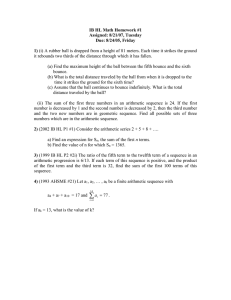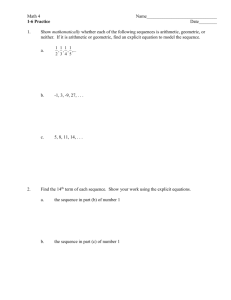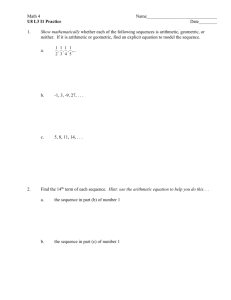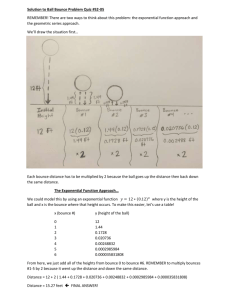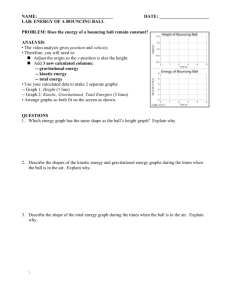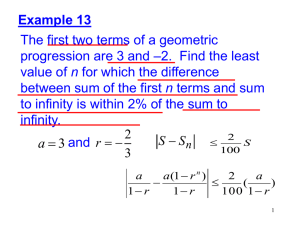IB HL Math Homework #1
advertisement
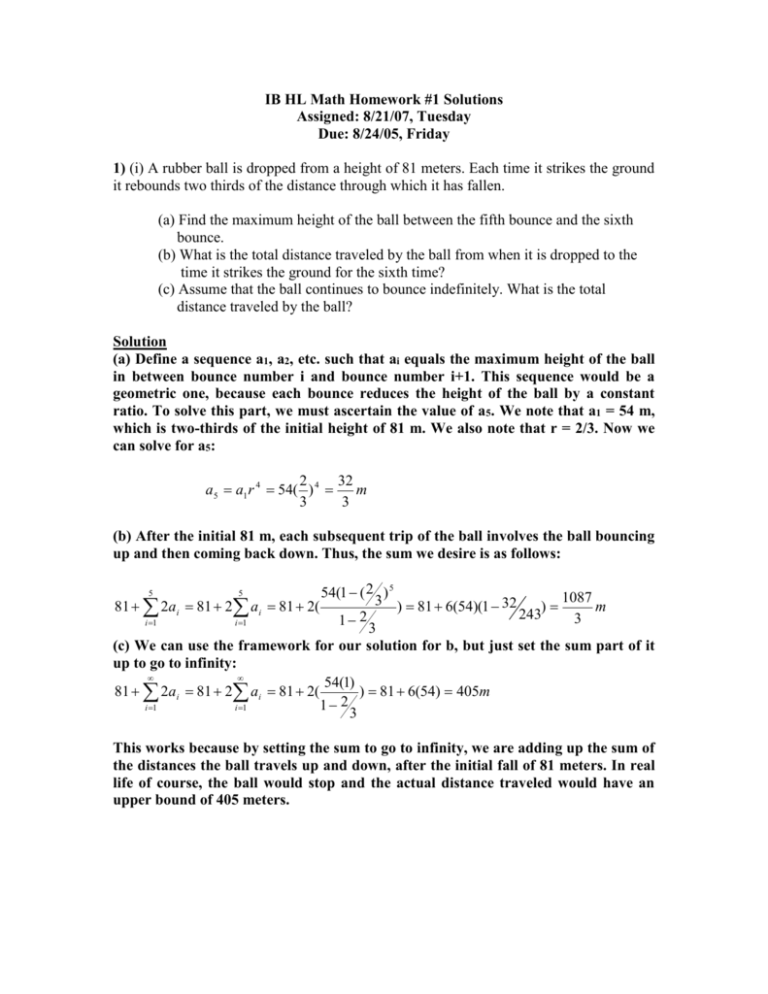
IB HL Math Homework #1 Solutions Assigned: 8/21/07, Tuesday Due: 8/24/05, Friday 1) (i) A rubber ball is dropped from a height of 81 meters. Each time it strikes the ground it rebounds two thirds of the distance through which it has fallen. (a) Find the maximum height of the ball between the fifth bounce and the sixth bounce. (b) What is the total distance traveled by the ball from when it is dropped to the time it strikes the ground for the sixth time? (c) Assume that the ball continues to bounce indefinitely. What is the total distance traveled by the ball? Solution (a) Define a sequence a1, a2, etc. such that ai equals the maximum height of the ball in between bounce number i and bounce number i+1. This sequence would be a geometric one, because each bounce reduces the height of the ball by a constant ratio. To solve this part, we must ascertain the value of a5. We note that a1 = 54 m, which is two-thirds of the initial height of 81 m. We also note that r = 2/3. Now we can solve for a5: 2 32 a5 a1 r 4 54( ) 4 m 3 3 (b) After the initial 81 m, each subsequent trip of the ball involves the ball bouncing up and then coming back down. Thus, the sum we desire is as follows: 54(1 ( 2 ) 5 1087 3 ) 81 6(54)(1 32 81 2ai 81 2 ai 81 2( ) m 243 2 3 1 i 1 i 1 3 (c) We can use the framework for our solution for b, but just set the sum part of it up to go to infinity: 54(1) 81 2ai 81 2 ai 81 2( ) 81 6(54) 405m 1 2 i 1 i 1 3 5 5 This works because by setting the sum to go to infinity, we are adding up the sum of the distances the ball travels up and down, after the initial fall of 81 meters. In real life of course, the ball would stop and the actual distance traveled would have an upper bound of 405 meters. (ii) The sum of the first three numbers in an arithmetic sequence is 24. If the first number is decreased by 1 and the second number is decreased by 2, then the third number and the two new numbers are in geometric sequence. Find all possible sets of three numbers which are in the arithmetic sequence. Solution Let the numbers in the arithmetic sequence by a, b and c, and let their common difference be d. It follows that a = b – d, and c = b + d. Thus, a + b + c = b – d + b + b + d = 3b = 24, so b = 8. Furthermore, we are given that a – 1, b – 2 = 6, and c are in geometric sequence, so we get the equations: 6 c a 1 6 Using that a – 1 = 8 – d – 1 = 7 – d, and that c = 8 + d, we have: 6 8d 7d 6 36 (7 d )(8 d ) 36 56 d d 2 d 2 d 20 0 (d 4)( d 5) 0 So d = 4 or d = -5. The first leads to the terms 4, 8, 12 and the second value of d leads to the terms 13, 8, 3. 2) (2002 IB HL P1 #1) Consider the arithmetic series 2 + 5 + 8 + …. a) Find an expression for Sn, the sum of the first n terms. b) Find the value of n for which Sn = 1365. Solution Let the first term of the sequence be a1 and the common difference be d. In general, we find that an = a1 + (n-1)d = 2 + (n-1)3 = 3n – 1. Thus, we can solve for Sn: Sn (a1 an )n n(2 3n 1) n(3n 1) . 2 2 2 Now, we find the value of n for which Sn = 1365: n(3n 1) 1365 2 3n 2 n 2730 0 (3n 91)( n 30) 0 , since n>0, n = 30. Sn 3) (1999 IB HL P2 #2i) The ratio of the fifth term to the twelfth term of a sequence in an arithmetic progression is 6/13. If each term of this sequence is positive, and the product of the first term and the third term is 32, find the sum of the first 100 terms of this sequence. Solution Let the arithmetic progression have the first term a1 and a common difference of d. We can set up the two following equations: a1 4d 6 a1 11d 13 13a1 52d 6a1 66d 7a1 14d a1 2d , substitute this value into the second equation. S100 (a1 a100 )100 50(4 202) 10300 2 a1 (a1 2d ) 32 2d (2d 2d ) 32 8d 2 32 d 2 , since d > 0. and a1 4 . 4) (1993 AHSME #21) Let a1, a2, … , ak be a finite arithmetic sequence with 14 a4 + a7 + a10 = 17 and a i4 i 77 . If ak = 13, what is the value of k? Solution Let d be the common difference of the sequence and substitute into the given equations: 14 a4 a7 a10 17 a a1 3d a1 6d a1 9d 17 a 3a1 18d 17 11a1 88d 77 18(11) 17(11) 11a1 d 3 3 ----------------------------------44 2 22d , so d 3 3 i 77 1 (i 1)d 77 i4 14 i4 2 17 18( ) 3 5 . Now, solve for k: Then we have that a1 3 3 ak 5 2 (k 1) 13 , so k 18 . 3 3
